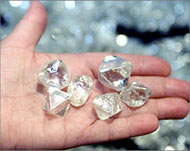Country profile: Guyana
In 1978, 900 followers of Jim Jones, the head of a religious cult known as The People’s Temple, committed ritual suicide in a small Guyanese village known as Jonestown.

This infamous incident was reported around the world and catapulted Guyana into the spotlight.
But Guyana’s modern history began nearly 500 years earlier, when in 1498 Europeans made their way to South America.
Ensuing centuries saw seemingly never-ending battles between the Spanish, French, Dutch and British to claim this land as their own.
The Dutch had settled Guyana by the late 16th Century and in 1667 the Treaty of Breda ceded all the English colonies in the area known as Guiana to the Dutch.
Colonies continued to change hands until the Congress of Vienna awarded the settlements of Berbice, Demerara, and Essequibo to Great Britain; they were then united as British Guiana in 1831.
Slavery was abolished in 1834 and thousands of indentured labourers were bought to Guiana to work on the sugar cane plantations.
The majority came from India but smaller numbers were from Portugal and China.
For the most part, these diverse cultures co-existed peacefully, though racial tensions have erupted periodically during the later half of the 20th century between the Afro-Guyanese and the Indo-Guyanese.
Over the years, domestic politics have been somewhat turbulent particularly during the 1950s and 60s.
 |
|
The Guyana flag |
The British deemed the government to be pro-communist and suspended the constitution in 1953.
During the 1960s, there was much civil unrest and this was later suspected to have been funded or provoked by the US Central Intelligence Agency (CIA).
Independence was achieved in 1966 and Guyana became a republic in 1970.
It embarked on a socialist path that unfortunately led to economic ruin. But when Cheddi Jagan was elected as president in 1992, many international analysts considered it the first free election since independence.
Situated on the northeastern shoulder of the South American continent, Guyana’s coastline is along the Atlantic Ocean and its many waterways reflect its namesake – Land of many waters.
The original inhabitants were Carab and Arawak tribes of Amerindians.
Capital: Georgetown
Official name: Cooperative Republic of Guyana
Previous name: British Guiana
Government type: Republic in the Commonwealth of Nations (formerly the British Commonwealth).
Population: 765,283 note: estimates for this country explicitly take into account the effects of excess mortality due to Aids; this can result in lower population and growth rates than would otherwise be expected (July 2005 estimate)
Languages: English, Amerindian dialects, Creole, Hindi, Urdu.
Ethnic diversity: East Indian 50%, black 36%, Amerindian 7%, white, Chinese, and mixed 7%.
Total population: 702,100.
Religion: Christian 50%, Hindu 35%, Muslim 10%, other 5%.
Political parties and leaders: Alliance for Guyana or AFG (includes Guyana Labor Party or GLP and Working People’s Alliance or WPA), Rupert Roopnaraine; Guyana Action Party or GAP, Paul Hardy; Guyana Labor Party or GLP, leader NA; People’s National Congress or PNC, Robert Herman Orlando Corbin; People’s Progressive Party/Civic or PPP/C, Bharrat Jadgdeo; Rise, Organise, and Rebuild or ROAR [Ravi Dev; The United Force or TUF, Manzoor Nadir.
Political pressure groups and leaders: Civil Liberties Action Committee or CLAC; Guyana Council of Indian Organisations or GCIO; Trades Union Congress or TUC.
International organisation participation includes: ACP, C, Caricom, CDB, FAO, G-77, IADB, IBRD, ICAO, ICCt, ICFTU, ICRM, IDA, IFAD, IFC, IFRCS, ILO, IMF, IMO, Interpol, IOC, ISO (subscriber), ITU, LAES, MIGA, NAM, OAS, OIC, OPANAL, OPCW, PCA, RG, UN, UNCTAD, UNESCO, UNIDO, UPU, WCL, WCO, WFTU, WHO, WIPO, WMO, WTO.
Military branches: Guyana Defence Force: Ground Forces, Coast Guard, Air Corps, Guyana People’s Militia Military manpower – there are approximately 206,098 (2005 est) males aged 18-49 are available for military service if the need arises.
Geography
Location: Northern South America, bordering the North Atlantic Ocean, between Suriname and Venezuela.
Area: total: 214,970sq km; land: 196,850sq km; water: 18,120sq km.
Land boundaries: Total: 2462km; border countries: Brazil 1119km, Suriname 600km, Venezuela 743km.
 |
|
Diamonds are a natural resource |
Coastline: 459km
Maritime claims: Territorial sea: 12nm; exclusive economic zone: 200 nm; continental shelf: 200nm or to the outer edge of the continental margin
Climate: Tropical; hot, humid, moderated by northeast trade winds; two rainy seasons (May to mid-August, mid-November to mid-January.
Terrain: Rolling highlands; low coastal plain; savanna in south
Natural resources: Bauxite, gold, diamonds, hardwood timber, shrimp, fish.
Land use: Arable land: 2.44%; permanent crops: 0.15%; other: 97.41% (2001)
Natural hazards: Flash floods are a constant threat during rainy seasons.
Environment – current issues: Water pollution from sewage and agricultural and industrial chemicals; deforestation.
Environment – international agreements: Party to: Biodiversity, Climate Change, Climate Change-Kyoto Protocol, Desertification, Endangered Species, Hazardous Wastes, Law of the Sea, Ozone Layer Protection, Ship Pollution, Tropical Timber 83, Tropical Timber 94.
Economy: The Guyanese economy has demonstrated moderate economic growth due to expansion in its mining and agricultural sectors.
These industries are the chief economic activities of Guyana. However, a chronic shortage of skilled labour and a deficient infrastructure have been debilitating.
The chief export is bauxite. Manganese, gold and diamonds are also mined. The bauxite mining industry should benefit from its imminent restructuring and partial privatisation. Guyana has a large external debt and a dire need for foreign investment.
GDP: $3743.05 per person.
GDP – real growth rate: 1.9% (2004 estimate).
Industries: Bauxite, sugar, rice milling, timber, textiles, gold.
Exports: Sugar, bauxite/alumina, rice, shrimp, molasses, gold, rum, timber.
Imports: Manufactures, machinery, petroleum, food.
Labour force: 418,000 (2001 estimate).
Unemployment rate: 9.1% (understated) (2000)
Currency: Guyanese dollar.
Transnational issues: There are long-standing maritime disputes with Venezuela. Suriname claims a triangle of land in a historic dispute over the headwaters of the Courantyne River. Guyana and Suriname are also involved in a dispute, to be arbitrated by the United Nations, over potentially oil-rich waters.
Sources: US Department of State. CIA World Factbook, Infoplease.com, Nationmaster.com, University of Texas.